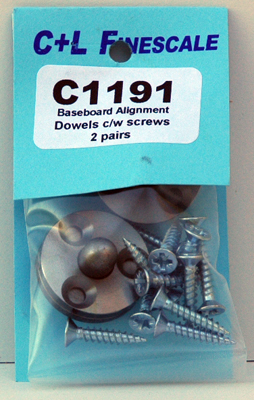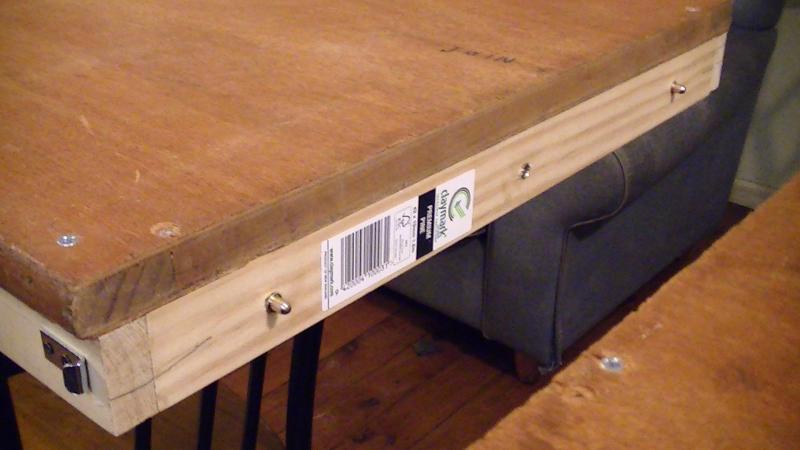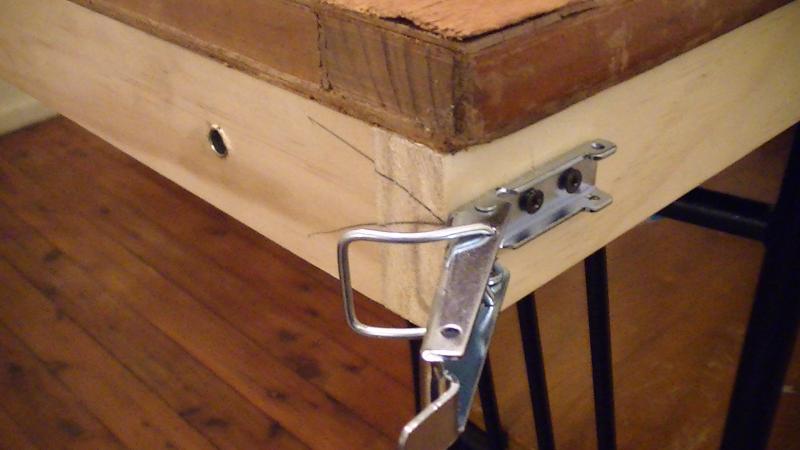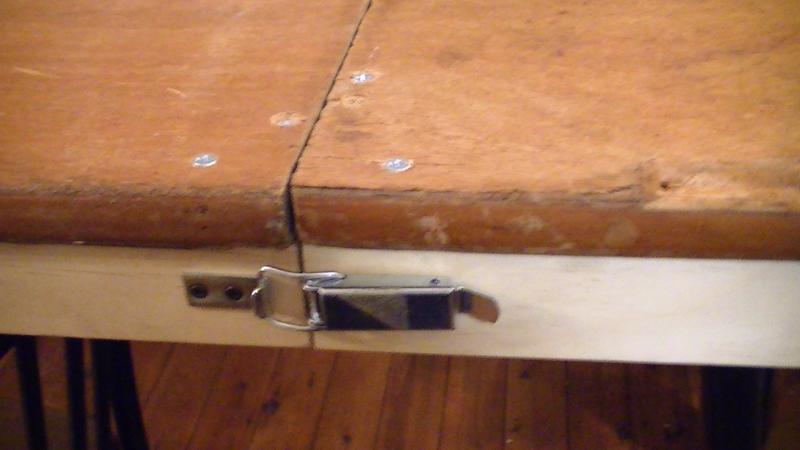Connecting Baseboards
Posted
#149399
(In Topic #8244)
Banned
Has any modeller used these ??
G'day all,I'm looking at ways of connecting my baseboards together and found these on ebay. Has any modeller used these toggles/clips for connecting boards together ?
See here ; http://www.ebay.com.au/itm/110998557615?ssPageName=STRK:MEWAX:IT&_trksid=p3984.m1423.l2649
I am thinking about using the clips along the side of the framing timbers, instead of bolts underneath the boards. Before anyone asks, yes, I will use the alignment dowels between the boards !
Cheers, Gary.
Posted
Inactive Member
They were successful as I remember.
Let me see if I can find them in the index.
Back soon.
Max
Port Elderley
Port Elderley
Posted
Inactive Member
Hopefully the perpetrator will be along soon.
Max
Port Elderley
Port Elderley
Posted
Banned
Cheers, Gary.
Posted
Full Member

John
John
Posted
Inactive Member
Regards,
Brian
ECoS, Laptop, TrainController Gold v8
Brian
ECoS, Laptop, TrainController Gold v8
Posted
Full Member
I have had to set up and take apart badly joined layouts far too many times for my liking.
I now use these:- http://www.screwfix.com/p/4-pronged-tee-nut-m6-x-9-pack-of-10/79359
and these:- http://www.tandsarchitectural.co.uk/productDetail.asp?PID=54610&categoryID=5580&feedID=1
and I mount them in an easy place to get to, at the side of the baseboards if possible.
I also recommend that you use legs/supports that don't allow the layout to drop to the floor if someone else unscrews all the bolts to be helpful:roll:. The simplest way to do this is to use the type of trestle legs that clamp at the top. I designed bespoke legs that had a slot in them that would allow the layout to came apart just enough to free the dowels but no further. 40 feet of layout makes a very loud bang when it hits the floor in one piece:roll::shock:

Posted
Banned
The link shows the alignment dowels that come with the clamps. They look easy to fit.
Hi Simonmcp,
The 4 way T-nuts are available from the same supplier that the clips and dowels are from. I did look at them, but I'm going to go with the type I proposed.
Cheers, Gary.
Posted
Full Member
James
Posted
Full Member
The difference is the tolerance between the pin and socket. Pattern-maker's dowels are usually, as their name would suggest, very accurately machined and matched. They are also considerably more expensive than "normal" alignment dowels.
Those shown in the C&L packet are pattern-maker's dowels. They are extremely accurate (if fitted properly) but do need a little care to fit.
'Petermac
Posted
Full Member
This would work well on a fixed set-up Brian but, IMHO, not on an exhibition layout nor one that has to be dismantled and re-assembled for any reason.Perhaps I am just a bodger, but I use wooden furniture dowels glued in one baseboard and a push-pull fit in the other. I use a single m5 bolt with a wing nut run up finger tight to hold the boards together. I find that this gives accurate joining and I can usually fit the bolts by feel rather than crawling underneath.
The wooden dowels break extremely easily, the ends would very quickly become burred preventing them entering the drilled hole on the facing board and also, any change in temperature (into a heated hall/out into a cold van etc. etc.) results in a change in humidity. These "furniture dowels" are designed to swell as they get damp and, once swollen, they don't shrink again. That's how they make such a good join in timber-work - the moisture in the wood glue makes them swell so they fit tightly in their socket.
'Petermac
Posted
Banned
Arrived home this afternoon to find a few deliveries had arrived. One of them were the alignment dowels and clips I showed at the beginning of this thread. Here are a few pics of the dowels and clips, which actually hold the boards together quite well. Total cost of the dowels and clips was only GBP 4.50 plus 4.00 delivery. Anything similar here in Oz would have cost a few dollars more..

This pic shows from left, the clip 'catch', male dowel, female socket (middle) and another male (far right).

This is the clip in place with another (opposing) female socket to the left of the clip.

The baseboards clipped together… and they are actually quite firm !
Cheers, Gary.
 Last edit: by Gary
Last edit: by Gary
Posted
Full Member
Station Road Baseboards - Railway Train Baseboard Alignment Dowels
Paul
Posted
Guest user
Alan in the Outer Hebrides
Posted
Full Member
Staying on the thread Kevin.
Posted
Full Member
The debate about pattern-makers dowels and alignment dowels has gone of for years with manufacturers/suppliers making a steady profit from modellers/diorama builders etc.
With pattern makers dowels perfect initial alignment of each of the two large circular portions of the pair is difficult and critical when the boards are already at their finished size/thickness. In practice, they are used to align exactly two or more parts of a pattern for a sand box casting, say, the top and bottom halves of a pipework element like a tee-joint before the pattern is completed in its exactitude. In mass production the patterns would be used over and over again in a hot, abrasive environment. The large flat part gives stability against being knocked out of position.
This degree of robustness is not required of a model railway, but Rule 1 applies if your pocket is deep enough……
Alignment dowels, depending on the manufacturer, simply allows a hole to be drilled between two components already clamped/screwed together, and the insertion of a 'hole and bullet' device which will in perpetuity allow the repeated alignment of the components. They are very very much cheaper that P'makers dowels.
You might also consider this option. The requisite copper pieces in UK are called 'slip couplings'. Like a straight joiner, but with no central depth stop.
http://yourmodelrailway.net/view_topic.php?id=3124&forum_id=5&highlight=earwig
'You may share the labours of the great, but you will not share the spoil…' Aesop's Fables
"Beer is proof that God loves us and wants us to be happy" - Benjamin Franklin
In the land of the slap-dash and implausible, mediocrity is king
"Beer is proof that God loves us and wants us to be happy" - Benjamin Franklin
In the land of the slap-dash and implausible, mediocrity is king
Posted
Banned
Again, it's a matter of personal preference. If you are rolling boards together when you wish to run trains, bolts would be ok to use. It would depend if you want to be getting under the baseboard every time you wish to run a few trains and have to tighten up the nuts/bolts. I prefered the alignment dowels (purchased from Station Road Baseboards, link above) and clips, as they gave me that flexibility to unassemble the layout for storage. I have used nuts and bolts previously and they work just as good. The alignment dowels and clips use are excellent, and make putting the layout together quite easy and quickly.
Cheers, Gary.
1 guest and 0 members have just viewed this.

